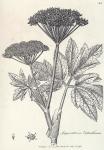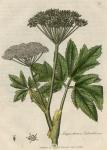035. Imperatoria ostruthium. Common masterwort.

 Synonyma. Imperatoria. Pharm. Edinb. J. Bauh. iii. 137. Gerard emac. 1001. Hal. Stirp. Helv. No. 805.
Synonyma. Imperatoria. Pharm. Edinb. J. Bauh. iii. 137. Gerard emac. 1001. Hal. Stirp. Helv. No. 805.
Imperatoria major. Bauh. Pin. 156.
Imperatoria sive Astrantia vulgaris. Park. Theat. 942.
Common Masterwort, by some erroneously Pellitory of Spain. Raii. Hist. 436.
Magistrantia. Comer. Epit. 591.
Imperatoria Ostruthium. Withering. Bot. Arrang. Lightfoot Flor. Scot.
Class Pentandria. Ord. Digynia. L. Gen. Plant. 356.
Imperatoria Ostruthium. L. Sp. Pl. 371.
Ess. Gen. Ch. Fructus subrotundus, compressus, medio gibbus, margine cinctus. Petala inflexo-marginata.
Spec. Char.
This is the only Imperatoria described by Linnaeus. The root is perennial, large, fleshy, succulent, round, tapering, rough, articulated, externally brown, internally whitish, creeping, and sends off many lateral fibres: the stalk is thick, striated, round, jointed, and rises about two feet in height: the leaves are compound, and proceed alternately from long footstalks, which supply the stalk with a sheathy covering at each articulation; the simple leaves are ovato-elliptical, pointed, irregularly serrated, and placed in treble ternaries, and the terminal leaf is commonly cut into three lobes: the general umbels are large, flat, and terminal; the partial umbel convex and unequal; there is no general involucrum; the partial involucrum consists of one or two slender leaves, nearly of the length of the radii; each flower is composed of five oval petals, which are of equal size, white, notched, and having their points bent inwards; the five filaments are tapering, white, erect, and longer than the corolla; the anthers are double; the germen is roundish, striated, truncated, above white, beneath greenish: the two styles are tapering, spreading, and a little shorter than the stamina; the stigmata are simple and obtuse. The flowers appear in May and July.
Masterwort may be considered as a native of Scotland, Mr. Lightfoot having found it growing in several places on the banks of the Clyde. It is frequently cultivated in our gardens; but the root, which is the part directed for medical use, is greatly inferior to that produced in the South of Europe, especially in mountainous situations: hence the shops are commonly supplied with it from the Alps and Pyrenees.
This root has a fragrant smell, and a bitterish pungent taste, leaving a glowing warmth in the mouth for some time after it has been chewed. Its virtues are extracted both by watery and spirituous menstrua, but more completely by the latter.
This plant, as its name ["Imperatoria ob raras & praestantes facilitates nominata suit." Vide Bauh. Pin. f. c.] imports, was formerly thought to be of singular efficacy, and was preferred to most of the other aromatics, for its alexipharmic and sudorific powers. In some diseases [The diseases, in which it has been chiefly recommended, are Hysteria, Hydrops, Colica, Paralysis, Vermes, Febres intermittentes. It has been also used as a sialagogue.] it was employed with so much success as to be distinguished by the name of "divinum remedium." [C. Hoffman. Officin. L. 2. c. 116.] At present, however, physicians consider this root merely as an aromatic, and it is of course superseded by many of that class of a superior character. Half a dram of the root in substance, and one dram of it in infusion, is the dose directed.

